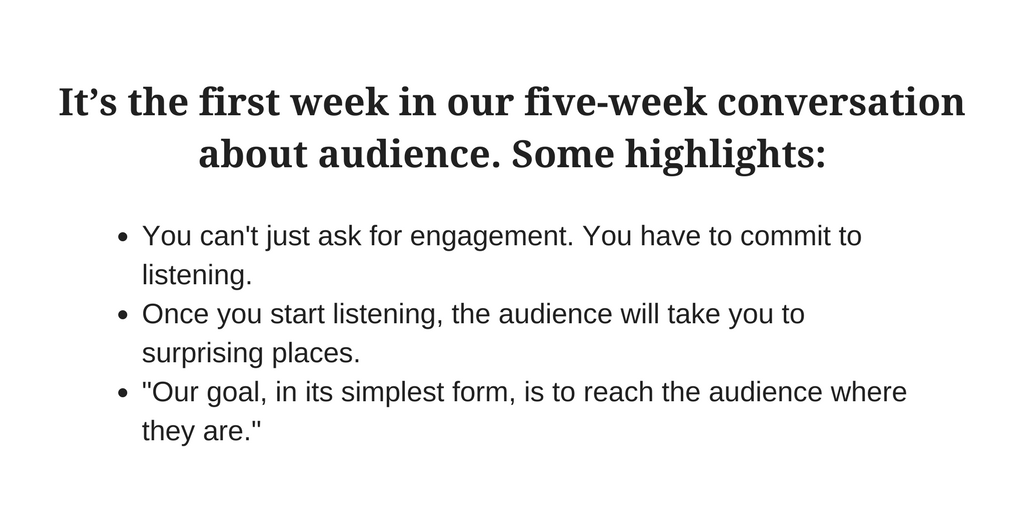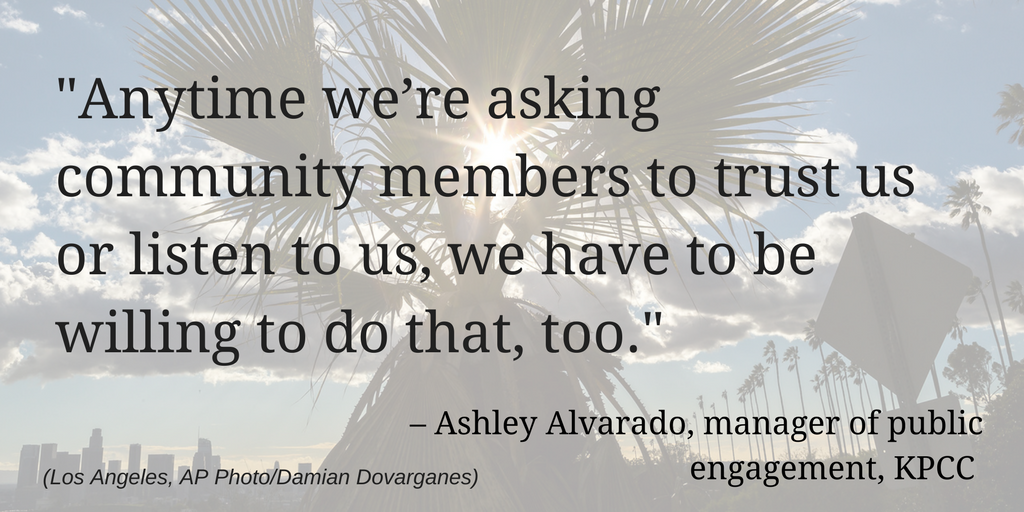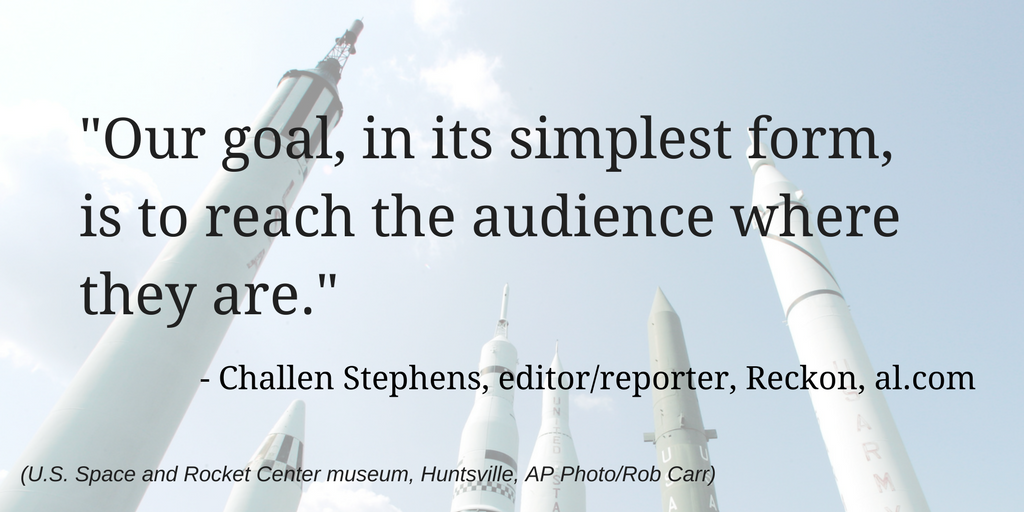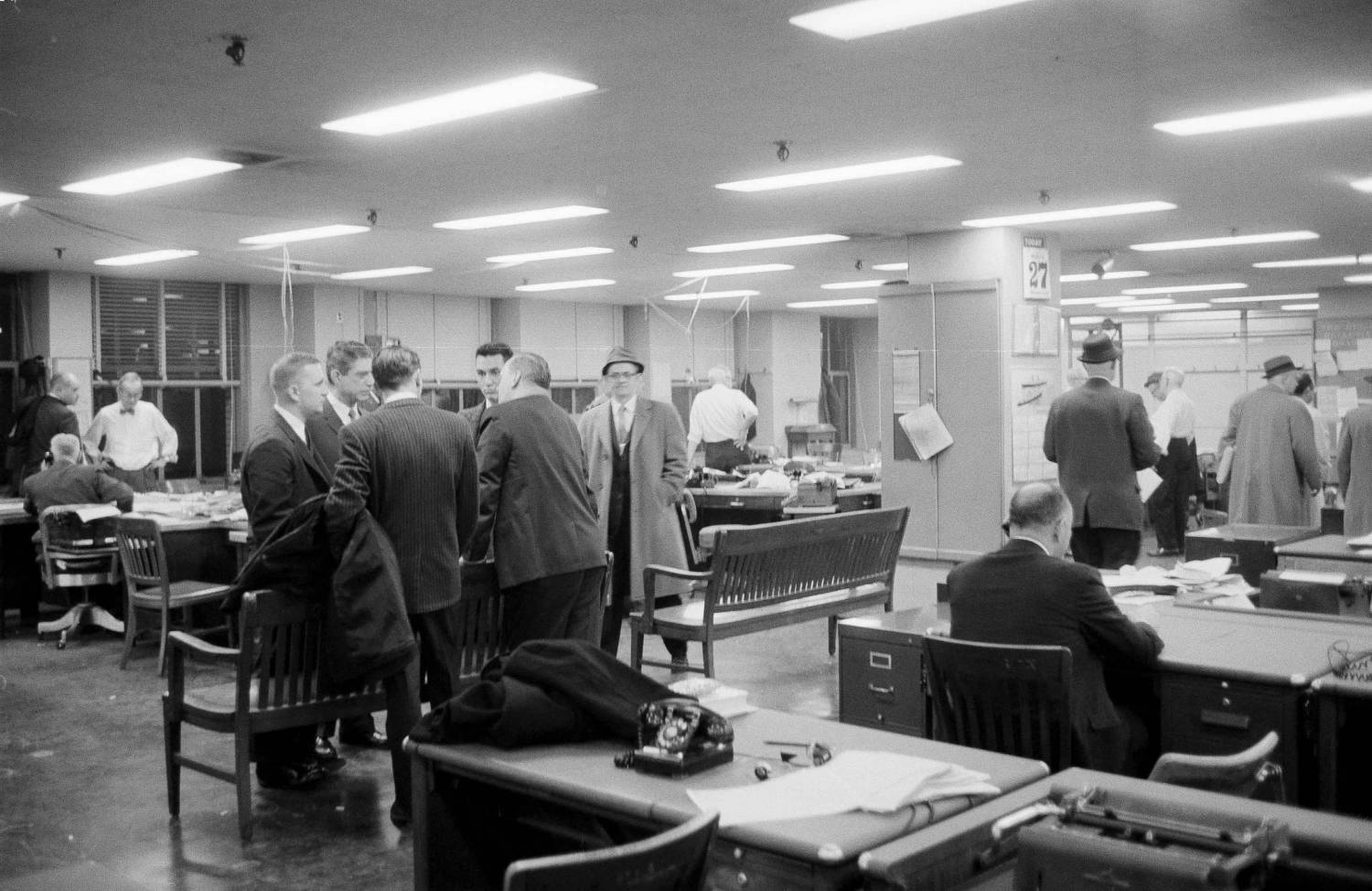This piece originally appeared in Local Edition, our newsletter following the digital transformation of local news. Want to be part of the conversation? You can sign up here.

KPCC wanted to discover stories that weren’t getting told in the media. So the Southern California public radio station reached out with a simple request: tell us your story.
To find people, they used the Public Insight Network, GroundSource, their social channels and a campaign of 6,000 postcards at county libraries.
The result: 250 responses and a series of packed live shows with a majority of people who hadn’t RSVP’d to events before. Throughout the process, KPCC asked participants for feedback.
“The one thing we got was ‘you don’t have enough older people,” said Ashley Alvarado, KPCC’s manager of public engagement. That’s something she’s listening to as they plan the next phase of “Unheard L.A.”
“But at the same time, it’s this moment of going, ‘When has public radio ever been dinged for not having enough older people?’ It’s just such a new and neat issue to have. We just had such incredible diversity.”
Last week, Ashley and Challen Stephens, an editor and reporter at al.com, spoke with me about how and why journalists need to be in conversation with their audiences. Our conversation was edited for length and clarity.
Next week, it’s your turn. Do the best story ideas come from journalists? Does your audience know better than you? Share your thoughts on connecting with your communities, and I’ll feature them in next week’s newsletter.

Can you each tell us about yourselves and your work?
Ashley: One of the things that I tend to tell people when I’m trying to describe my job as simply as possible is that I’m a professional fangirl. And that means that I spend a lot of time in the community, whether that’s in person or digitally, meeting folks and getting excited about who they are, the work they’re doing and trying to connect it back to our newsroom. And then I do it the other way around. How can I get people excited and engaged about what’s coming out of our newsroom and community? How can I make that easier to digest?
I’m just trying to close that gap between community and KPCC, being more reflective of those we aim to serve.
Challen: I am a longtime newspaper reporter, and I am now the director of our statewide socially-focused brand called Reckon here at al.com.
We moved online when the readers went online, and now we’re moving toward being social-first in our thinking and the way we present the news, and we’re going where the readers consume the news. While we still have print products and digital products, we now also have a social news brand here.
I love the name Reckon and was excited when I first saw it. What is it? Is it a Facebook platform? How does it work?
Challen: There is definitely a Facebook platform and that is probably the main body of Reckon right now. It works in myriad ways. Some content on Reckon might be a traditional longform story that originates on al.com and then is shared to Reckon. But other items might originate just on Facebook, a data graphic, or we do a lot of video reports that start on Reckon. Some of them might be shared back on al.com, some of them might not. Some of them might live only on Facebook or on other social accounts.
Really the big change here is when we’re talking about the news, we start with thinking about what is shareable, but not just shareable. What travels on social? How do people consume the news and how can we make this more user-friendly so that this finds and audience and this finds the audience in the way they want to be found.
Ashley, how does KPCC interact with your audience?
Ashley: We became a Hearken newsroom at the beginning of this year. We’ve used GroundSource off and on for the last few years. We’ve been a Public Insight Network newsroom for as long as I’ve been here. We do in-person events throughout the year, and what’s cool about that is the KPCC In Person team is part of the content team.
We’ll do events called “Feeding the Conversation” where I’ll work with a reporter or an education team or a show and we’ll have one or two KPCC journalists at the table and four or five community members. And we have prompts. So it’s not like I’m asking a journalist to do an interview but to just spend most of the time listening.
And then we’re on all of the social channels.
What about you, Challen, how does your newsroom interact with the audience?
Challen: Like Ashley, we’ve done a lot of community engagement. We’ve used Hearken and GroundSource and held community forums and invited readers to help us decide what we report on and how we report.
Reckon is just us adapting yet again and it’s the latest iteration on community engagement for us. Since it’s on social, it’s even more direct.
What’s the goal? Is it growing audience? Is it deepening their connection with you? Is it turning them into digital subscribers?
Challen: Our goal, in its simplest form, is to reach the audience where they are. Al.com is a large news entity with all sorts of information on it. And Reckon is our new social brand with what you might consider public interest journalism.
If you’re looking for the serious news, this is where you’re going to find it, and it’s going to come right to you, and you’re going to help us decide what to report on.
What about for you, Ashley, what’s the goal?
Ashley: With “Unheard L.A.” specifically, one of the goals was to prove out this theory that if you invest in community, if you work with them, there’s this opportunity to enrich your programming and reporting and that that helps with impact and audience growth.
Going with what Challen was saying, it’s how do we engage better with community members? How do we earn and have that trusted relationship? We’re always looking to be more reflective of the community.
With any of these projects, what does success look like?
Challen: I think success looks like a large, responsive audience. We are telling people something surprising and new, but they’re finding it, they’re engaging with it, they’re sharing it. I think success looks like growing the conversation.
Ashley: With “Unheard L.A.” specifically, it’s about proving the sustainability. One of the things I really try to focus on with new interns or staffers is understanding that engagement is about fostering a reciprocated relationship. Anytime we’re asking community members to trust us or listen to us, we have to be willing to do that, too.
I would guess that this connects back with the financial mission of your organization, in that building loyalty leads to subscribers, donors, members, supporters. Is that right?
Ashley: With the work that I do specifically, there are ways that people can engage and support what we’re doing without it being financial. When I look at these engagement sourcing lunches, when I look at “Unheard L.A.,” there are people who started as a Twitter followers. When we started to really pay attention to them, and they became ambassadors for the work that we’re trying to do.
Doing a better job with our job is what will get us to that sustainability.
Challen: I agree. In the long view, there are obviously business implications, but right now the focus is on audience and a new kind of content and basically adapting to the technological changes we’re having right now in this industry.
To be successful, we have to go where people want us to be, where they’ll find us.
If people want to be more responsive to their audiences, if they want to even begin considering their audiences by more than just reading the comments, which is honestly the place where a lot of people still are…
Ashley: If they’re even doing that.
…If they’re even doing that, right, where do they start?
Ashley: It’s being present. There are a ton of ways that you can do that, but what I would emphasize is being present for the long haul. So being present whether it’s physically at a coffee shop and having an open newsroom, doing what they’re doing in Honolulu with Facebook Live office hours, doing the Public Insight Network or GroundSource or Hearken, but if you do any of those things, you have to commit to reading what people send you.
If you’re doing all these asks and you’re never doing a give, then it’s going to be fruitless.
Challen: I’d say it begins with setting aside assumptions, assumptions that all the best ideas originate inside the newsroom, which was an old viewpoint. You begin listening to the audience, you begin letting them guide you in terms of what they find interesting. Sometimes they surprise you, sometimes you can anticipate it. Big news is always big news.
But sometimes there’s a lot more engagement around a topic than we anticipated, and we’re really agile about pivoting and going after what people want to know about.
We also do things like Ashley does. We start with a conversation. We’ve done a couple things with Spaceship Media out of Berkeley where we convene a group of participants, sometimes they’re readers, sometimes they’re just citizens of Alabama. We did it with Trump voters in Alabama and Clinton voters in the Berkeley area.
Right now we’re talking about the achievement gap, we’re going to roll out the first of those stories next week. They were mostly decided by 60 teachers who were engaging in a conversation on Facebook with us about what they care about, what they see, what they expect from children, what solutions they see to this problem.
Do you have any tips for people who want to do a better job reaching to their audience, or maybe even more significantly, making the case in their newsroom about why they need to be doing this?
Ashley: I’m part of the Gather Engagement Collaborative that’s coming together. We’re building case studies, and having those case studies helps. It’s such a competitive industry that you’re challenged by what others are doing and you’re inspired by it. I think that Jen Brandel does a better job than just about anybody in making sure that she’s finding the metrics and making sure she’s making the business case at the same time she’s making the editorial case.
And sometimes it’s just about striking out and doing it yourself. The first “Feeding the Conversation” that I did, I just did. We have a venue on site and I was able to make it work and people got excited about it. But it’s really about doing it.
When I say be present, go to other people’s events. Go and just be there. Listen. And work to be somebody that they’ll come to.
There are more and more organizations like Spaceship Media that are supporting and facilitating the kind of work that newsrooms can and should be doing. It’s an opportunity that can make things go from impossible to totally doable.
Challen: I guess I’d say stay agile. Don’t marry yourself to your internal plan. Don’t do it that way because you’ve always done it that way.
It sounds kind of trite to say go out and listen to the audience, but some places maybe haven’t even taken that step, and that’s really what you need to do.
When it starts working, it leads to interesting places. You’d be pretty surprised at the stories you find along the way.
Why does this matter?
Challen: I’d say it matters because this is the future in terms of how we consume information. I can’t think of why it would not matter. Ashley, you want to take this one?
Ashley: I sort of like what you were saying. How can this not matter?
Something that’s guided me since 7th grade is this really strong belief that information’s the greatest tool that we have. It’s the best way that we can defend ourselves and advocate for ourselves, and there’s a whole lot that we do to get in the way of people getting good information and sharing good information.
Engagement’s how we make it all possible.
Challen: We have a talented team here, we have a very engaged public, we have a lot of important information. I’d say it matters because what we’re doing is we’re working at connecting all the dots.

Thanks, Ashley and Challen, for talking audience with us! Now it’s your turn. I’ll share your thoughts next week.
In the meantime, there’s still time to apply to the Collaborative Reporting Project. The Listening Post Collective has new tools for newsroom engagement. And check out this Poynter Webinar next month on engaging audience with interactive video.
The Local Edition team (that’s me and Ben Mullin) plan to enjoy fireworks next Tuesday and not work, but you’ll find us back on Wednesday morning in your inbox. Have a great week!
Correction: Ashley Alvarado’s first name was bungled in a few spots, which is dumb because there’s only one way to spell Ashley. It has been corrected. We apologize for the error.







